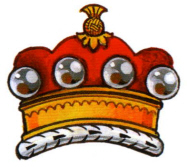
|
The Complete Guide to the British Peerage & Baronetage |
If you have found this page useful, why not make a donation to The Peerage Research Trust so that we can continue to maintain and develop Cracroft's Peerage?
____________________________________________________________________________________________________________
Barons of England

A baron's coronet
Dormant and Extinct English Baronies
One of the principal duties of the King's tenants-in-chief was to attend the Curia Regis, or King's Court, for the purpose of giving him counsel and of supplying the means of any extraordinary expenditure. The Curia Regis was the administrative centre of the kingdom, and from it grew the English Law courts and ultimately the English Parliaments. In theory all the King's tenants-in-chief should have been present from time to time at the Curia Regis, but in practice all were not, and by the provisions of Magna Carta in 1215 it was set down that the Archbishops, Bishops, Earls and greater Barons were to be summoned to the Council by writ addressed to each one in particular. Those who held of the King, as being tenants-in-chief, but were below the rank of the greater Barons, were by Magna Carta to be summoned by a general writ addressed to the sheriff of the county. It was from these greater Barons that the concept of a Baron as a Peer of Parliament developed. The first Baron to be created by Letters Patent rather than by writ of summons was John Beauchamp, who was created a Baron in 1387. Gradually creation by Letters Patent became the rule, and since the fifteenth century, except in those rare cases were there has been a genuine mistake or when the son of a Duke, Marquess or Earl is "accelerated" into a barony belonging to his father, all creations have been by patent.
A Baron is styled the "Right Honourable" and he is officially addressed by the Crown as "Our Right Trusty and Well Beloved". When a Baron or any other peer is a member of the Privy Council the word "Counsellor" is placed before his name, for instance: "Elizabeth......To Our Right Trusty and Well Beloved Counsellor, Robert Michael James, Baron Cecil of Essendon.....Greeting!".
In common with all peers, Barons are entitled to both coronation and parliamentary robes. The Coronation Robe, which, as the name suggests, is worn only at the Coronation of the Sovereign, is of crimson velvet, edged with white fur and having two rows of ermine on the white fur cape. Baronesses are entitled to wear coronation robes similar to those of a Baron, these being edged with a two inch border of white fur with a train a yard on the ground. The Parliamentary Robe of Estate of a Baron, which is worn for the State Opening of Parliament or by those taking part in the ceremony of Introduction of a new peer, is of fine scarlet cloth lined with taffeta. It is trimmed with two guards (or bands) of ermine and gold lace, and is tied at the left shoulder with a white ribbon.
Coronet - A plain circle of silver gilt, surmounted by six silver balls at equal distances; a cap of crimson velvet, turned up ermine, thereon a golden tassel.
_______________________________________________________________________________________________________________
ã Copyright: Heraldic Media Limited. All rights reserved.